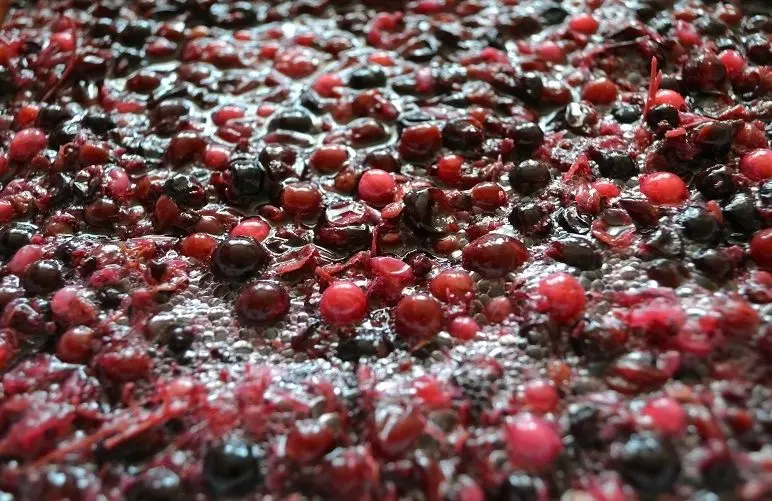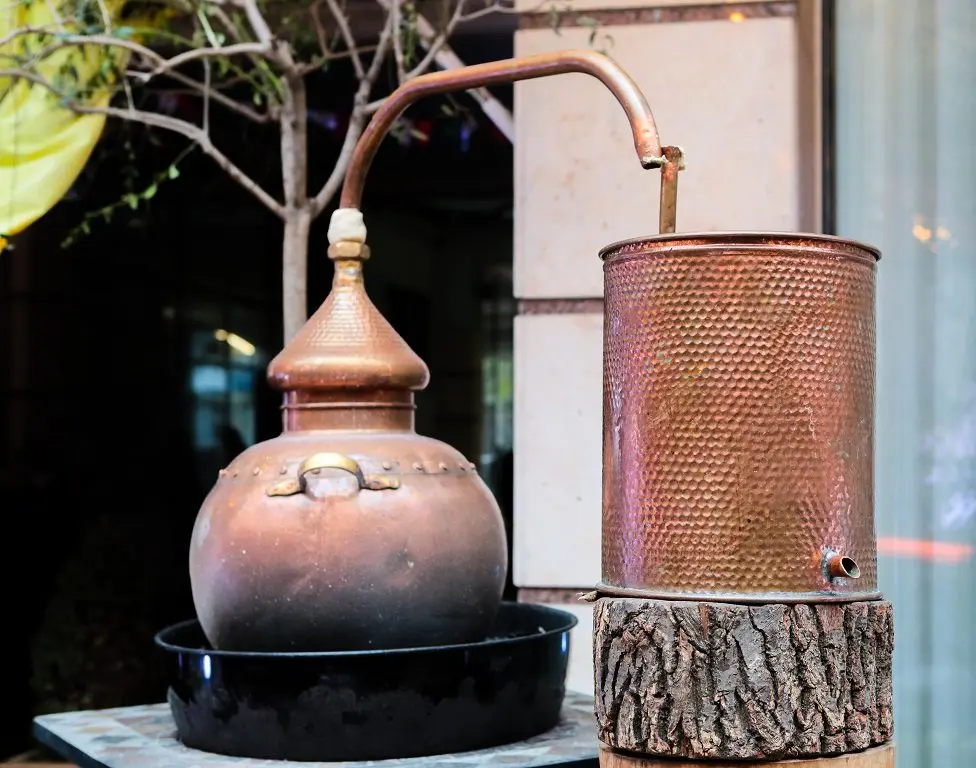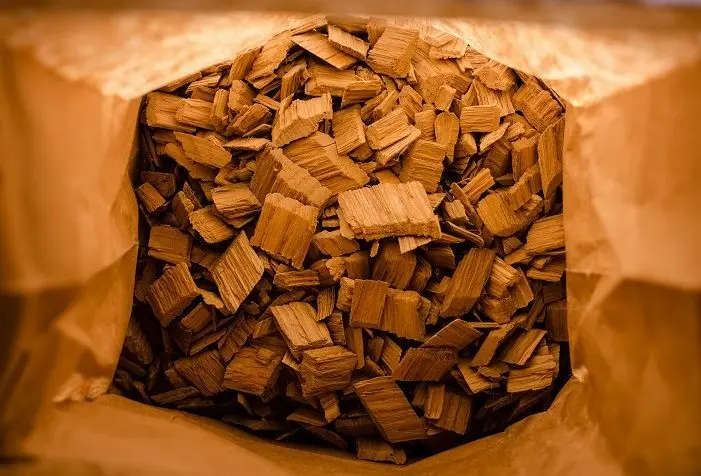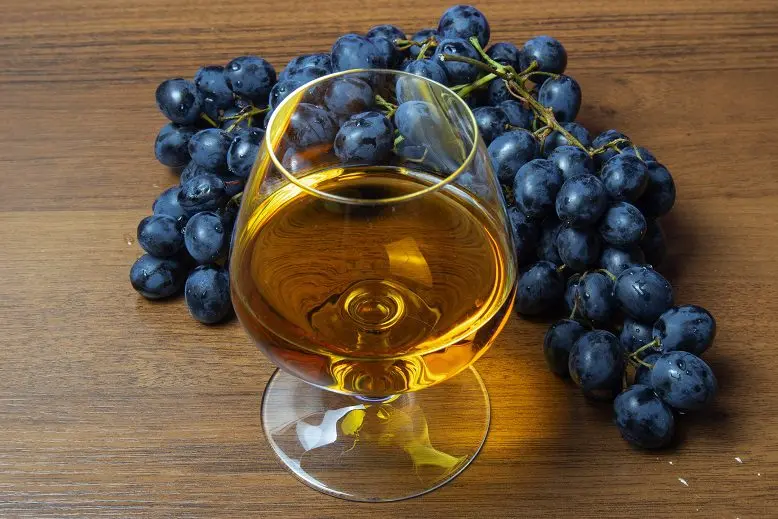Contents
The authors of most recipes suggest ennobling moonshine by imitating cognac taste and color by adding coffee, sugar or other ingredients. This time we will prepare a real cognac from grapes (brandy), trying to adhere to the classical technology as much as possible. It is difficult to surpass the French masters, but it is quite possible to get a decent drink at home.
White Muscat varieties with a specific aroma are best suited, but you can make cognac from any grape growing in the country or in the garden. With proper preparation, excellent drinks are obtained from the varieties Lydia, Isabella, Dove, Stepnyak, etc. The main thing is that the fruits are ripe. The only thing I do not advise you to use is Saperavi, Kakhet and Cabernet, because the tannins contained in these berries make wine alcohol too hard.
Ingredients:
- grapes – 30 kg;
- sugar – 2,5 kg (optional);
- water – 4 liters.
- oak pegs (or barrel).
Attention! The amount of water and sugar depends on the juiciness, sugar content and acidity of the grapes used. For ease of perception, I will indicate the exact proportions later when describing the technology itself. If the berries are sweet, sugar can be omitted, you will get pure wine alcohol with a wonderful aroma, but in the case of fruits grown in the northern regions, the yield of distillate without sugar will be very low.
grape cognac recipe
1. Preparation of wine material
Cognac alcohol is obtained by double or triple distillation of young wine in a moonshine still (copper alambik is used in France). Therefore, the first step is to prepare the wine.
Unwashed ripe grapes are separated from the bunches, then crushed together with the seeds. There is “wild” wine yeast on the surface of the grapes, so the berries cannot be washed, otherwise the must will not ferment. Very dirty fruits can be wiped with a dry cloth. Harvested after rain or washed berries, it is better to ferment with sourdough or store-bought wine yeast (the best option).
Pour the resulting mass into an enameled or plastic dish with a wide neck. Add sugar at the rate of 1 kg per 10 liters of crushed grapes (optional), water (1 liter per 7,5 kg of berries), mix. Cover the container with gauze (clean cloth) to protect against insects, put in a dark, warm place for 4 days.
After 12-18 hours, a “cap” of pulp will begin to form on the surface of the pan, which interferes with fermentation. This layer must be broken down by stirring the wort 2-3 times a day with a clean wooden stick or by hand. So that the future wine does not turn sour, I recommend starting to stir the must from the first day of fermentation.

After 4 days, the crushed grapes will show signs of fermentation: a characteristic wine smell, foam and hiss, all the pulp will float up. It’s time to filter the wort. To do this, carefully drain the juice from the sediment into another container, and squeeze the pulp itself through gauze (cloth) with your hands or a press, but without crushing the bones. Pour the liquid obtained after squeezing into a container with juice. Add sugar at the rate of 1 kg per 10 liters of juice (optional). Squeezes are no longer needed.
After stirring, pour the fermented grape juice into glass or plastic containers for fermentation, filling no more than 70% of the volume, so that there is room for carbon dioxide and foam. Next, install a water seal or a medical glove with a hole on the bottle (pierce with a needle). Move the container to a dark place with a temperature of 18-27°C.

On average, fermentation lasts 18-40 days (depending on temperature and yeast activity), then the water seal stops bubbling (the glove deflates), a layer of sediment appears at the bottom, and the wort becomes lighter. The result is wine material with a strength of 10-14 degrees. You can move on to the next step.
2. Obtaining wine alcohol
Drain the young wine from the sediment (for better cleaning, it is advisable to filter through gauze), pour into the distillation cube of the moonshine and distill at maximum speed (so that less harmful substances are released), without dividing into fractions. Stop the selection of alcohol when the fortress in the stream falls below 30 degrees.
After the first distillation, measure the strength of the distillate and determine the amount of pure alcohol. For example, 5 liters of 65% contains 3,25 liters of pure alcohol (5 * 0,65 = 3,25). Dilute all obtained grape moonshine with water up to 18-20%. Make a second distillation, collect the first 10-12% of the distillate from the amount of pure alcohol separately and pour it out. This is the upper fraction, called “heads”, which cannot be drunk due to the high concentration of harmful substances, including methanol and acetone. Finish selection when the strength in the jet falls below 30 degrees.
To obtain pure wine alcohol, one more distillation is required. Before starting double-distillation moonshine, dilute with water up to 20%. During the third run, pour out the first 4% of the amount of previously measured pure alcohol, these are “heads”. Collect distillate until the strength in the stream drops below 45%. A product from 45 to 30 degrees (called “tails”) can be used for other purposes, but it is not suitable for homemade cognac.

3. Infusion
In order for wine spirit (“body”) to turn into cognac, it must be insisted on oak. There are two options here. The first is to buy an oak barrel, but for various reasons, few people use this method. The second way is easier and cheaper – to insist on oak pegs (chips). Ready-made pegs can be found on sale or you can make your own.
You need an oak tree that is at least 50 years old, such trees have a trunk diameter of 30-35 cm. Bark, sawdust and shavings are not suitable, because they contain too many tannins that make cognac taste hard. It is desirable that the felled tree lie down in the rain and snow for several years, that is, it undergoes natural soaking, due to which the concentration of tannins decreases. Pour boiling water over fresh wood, drain the broth after 10 minutes, then soak in cold water for 20-30 minutes and dry.
Divide an oak stump 10-20 cm long into pieces 5-8 mm thick, along the length of the pegs should be placed in a three-liter jar in which we will infuse cognac. Next, place the pieces in jars (20-30 pieces each).

Before infusion, dilute the distillate with water to a strength of 42-45 degrees. Then pour the diluted cognac spirit into a jar with oak pegs, roll up the lid and put it in a dark, cool place (basement) for at least 6-12 months. The longer the homemade cognac is infused, the higher the quality. But keeping the drink for more than 3 years is impractical. Still, it’s not a barrel.
The taste and color depend on the properties of the wood. The aging time with pegs may be different, so at least once every 3-4 weeks you need to taste homemade cognac so as not to overexpose. Usually the peg makers indicate the amount and the optimal steeping time, these instructions should be followed.
4. Caramelization
An optional step during which the color of cognac is changed and the taste is slightly softened.
Even after a year of aging in an oak wood jar, homemade cognac does not always acquire its characteristic dark color. If this does not suit you, you need to do caramelization. Caramel is also added to almost all French cognacs, so there is nothing wrong with that.
The process of making caramel is described in the following video.
The amount of caramel added to cognac depends on individual preferences. Personally, I use no more than 50 grams per 3 liters. Next, mix the cognac, cork and hold for 7-10 days.
5. Bottling
At the final stage, filter the homemade cognac through a layer of cotton wool and bottle it. Cooking is over, you can start tasting.










